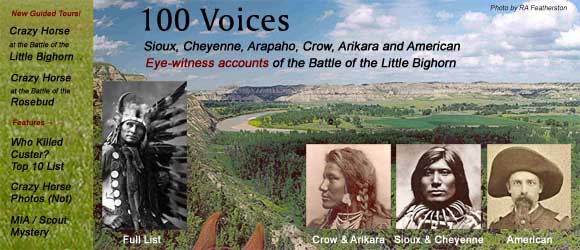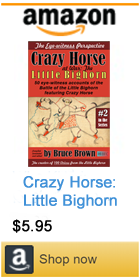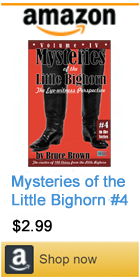|
||||||||||||
Bruce Brown's 100 Voices... Staning Bear's Story of the Battle, #3
STANDING BEAR'S ACCOUNT
Says that Custer's dust was seen approaching the village over low ground to the east, down a kind of dry coulee. As soon as the soldiers came in sight they halted and apparently were preparing for a charge. All this time the Ogalallas were getting ready. Finally the soldiers advanced very near to the river, but before they could cross were engaged by the Indians and forced back to the ridge where the main fight took place. [Note: actually, according to the eye-witness record, Custer rode to river at Medicine Tail Coulee, scouted briefly for a better place to cross, and then led the charge across the Little Bighorn that suddenly halted mid-river when White Cow Bull shot an officer on a "sorrel horse with... four white stockings," who can only be Custer. See Who Killed Custer -- The Eye-Witness Answer for more info.] Says as soon as Custer came in sight and halted, some of the Indians crossed over, but he advanced against this resistance nearly to the river before it became strong enough to check him. [Note: these could be the few Indians who White Cow Bull and Foolish Elk saw Custer's troops chase to the river at Medicine Tail Coulee.] Says that the Indians first prepared to fight were the ones camped farthest from the river. While Reno's battle was going on, Crazy Horse was getting his warriors ready, and before they were ready the other soldiers (Custer) appeared. Crazy Horse, however, took time to consult the medicine man and invoke the spirits. This he did very coolly, and he delayed so long that many of his warriors became impatient. Was on bluffs (where Kanipe saw Indians), and Custer went down coulee into Medicine Tail and crossed over to Custer ridge in full view of village. Custer's soldiers did not fire into village. On my map I should change places with Minneconjou and Sans Arc camps. Ogalallas were not on river at all but over toward bluffs to west of Brule and Sans Arc. Custer's men did not fight by companies but all were together all the time. Could not make him say different. His recollection clear on this point. The gray horses mixed in with rest and but few horses got beyond Keogh. Nearly all killed or captured before got farther than this. Keogh is the first place where any of the soldiers stopped to fight. Those between Custer and river were soldiers running toward river on foot. Between Calhoun and monument there were Indians both sides of river as soldiers went along. The soldiers killed between Custer and river were men on foot trying to make the river, and they were killed in the deep ravine. Standing Bear took a buckskin shirt from one of the dead men and gave it to his mother, and she kept it many years and finally cut it up. At the time he supposed this to be the only buckskin shirt that was found, and he therefore for some years supposed he had Custer's shirt, whom he (after the battle) was told wore such a shirt. In talking with other Indians, however, he found it was claimed that other buckskin shirts were found among the dead. At the time of the battle and while in the vicinity, no Indian recognized Custer's body, nor even supposed they had been fighting Peoushi [Long Hair, or Custer]. He saw the three Indian scouts killed with Reno and one of these they took to be Sioux (This must have been Bloody Knife, who was part Sioux) [Camp is wrong here. According to the eye-witness record, there were probably a half dozen mercinary Indian scouts killed with the Seventh Cavalry that day, and several may have been full blooded Sioux.] Walter Mason Camp's Notes: 1. Walter Camp field notes, folder 20 and 55, BYU Library. Custer in '76: Walter Camp's Notes on the Custer Fight, edited by Kenneth Hammer, Brigham Young University Press 1976 p 214 - 215
Standing Bear was Iron Hail's brother. Here is a 1910 account of the battle by Standing Bear, another 1910 account, and an undated account, plus Standing Bear's recollection of the great Sun Dance before the battle where Sitting Bull had a vision that the bluecoat soldiers fell from the sky and all died.
|
||||||||||||




 SAYS BLACK BEAR and several others early in morning of June 25 were up on divide going off on a visit, and as they proceeded they crossed the trail of the Sioux leading into valley of Little Bighorn. This trail was then several days old and there was something about it that attracted their attention, and upon closer inspection, they discovered a fresh trail of shod horse tracks on the older trail. Having fought soldiers (Crook) only a few days before, their suspicions were at once aroused, and one of them proposed that they ride back to the top of the divide and take a look around, which they quickly did.
SAYS BLACK BEAR and several others early in morning of June 25 were up on divide going off on a visit, and as they proceeded they crossed the trail of the Sioux leading into valley of Little Bighorn. This trail was then several days old and there was something about it that attracted their attention, and upon closer inspection, they discovered a fresh trail of shod horse tracks on the older trail. Having fought soldiers (Crook) only a few days before, their suspicions were at once aroused, and one of them proposed that they ride back to the top of the divide and take a look around, which they quickly did.







